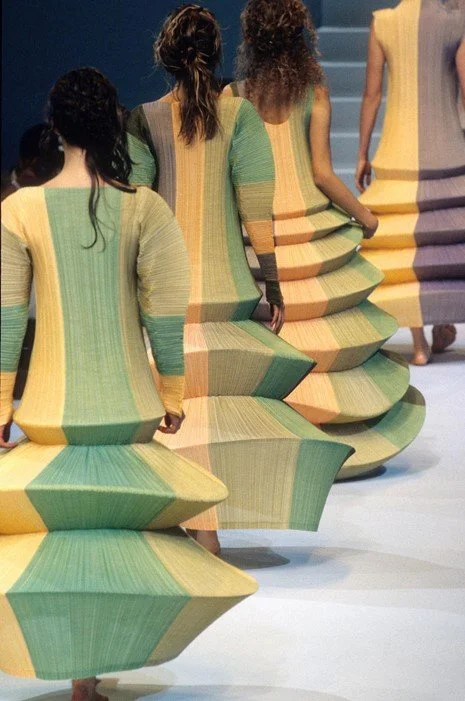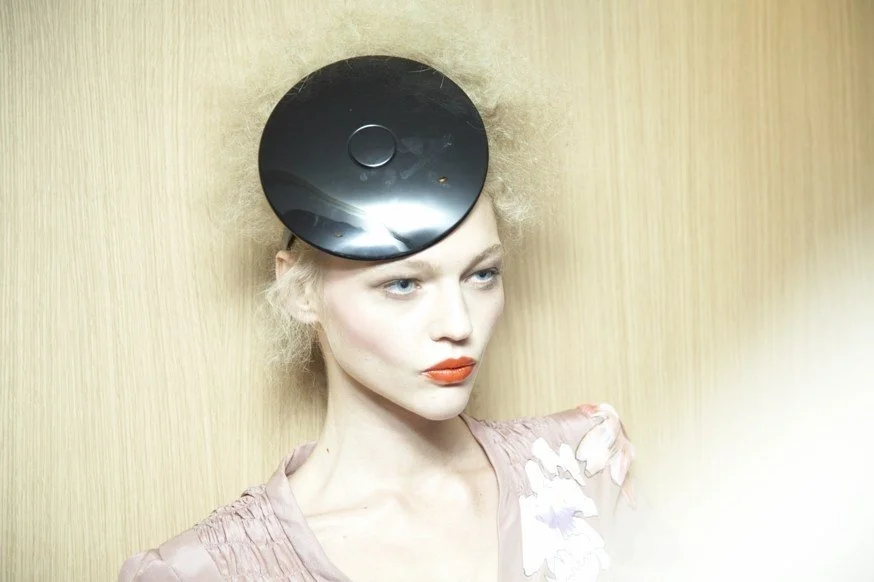Art In Fashion
Art has always inspired the world of fashion. In particular, in the late sixties, artistic movements such as Poor Art and Body Art profoundly influenced designers like Sonia Rykiel, Issey Miyake, and Rei Kawakubo.
Comme des Garçons SS17Photography Evan Schreiber
Body Art and Sonia Rykiel
"May the flesh explode through the fibers, tearing and bursting like in a Francis Bacon painting where nothing subsides, and may it flow, simply." These words belong to Sonia Rykiel, a French designer closely aligned with the Body Art movement that emerged in the late 1960s with artists like Gina Pane, Marina Abramovic, and Vito Acconci. Body Art views the body as an artistic object, with themes of corporeality closely tied to the historical events of the late '60s, such as the student and workers' movements of '68. There is a need for self-discovery through happenings and performances that highlight the sensuality of the body, making it the protagonist and the artwork itself. Rykiel is immersed in this artistic climate, evident in her own words from her first book titled "And I Would Like It Naked." The dress itself becomes a desiring organ. Rykiel advocates for a body without veils, free from barriers between fabric and skin. Stripping away underwear and other fabric diaphragms unleashes sensations that celebrate the triumph of a body's physiology. With Rykiel, the dress itself becomes a kind of secret membrane of the skin. "Everywhere, in colors, under forms, in pockets. The dress covers me, invisible. It enters me, eats my soul, massacres me, devours my body. Take flight, my dress, pierce their hearts... this garment is my work, my life for six months," she writes in her book.
Poor Art: Issey Miyake and Rei Kawakubo
Issey Miyake SS95via the-rosenrot.com
In the midst of the '68 turmoil in Paris, Issey Miyake finds himself. The youth, largely university students alongside workers, take to the streets to contest authorities. A subculture develops, following the ideologies of Herbert Marcuse and Guy Debord, expressing distrust of machinery, industrial products, and the Grand Promise. This period represents the rejection of the beautiful object and, consequently, Pop Art, with opposing artistic currents like Poor Art and Body Art. Miyake is immersed in this general atmosphere, representing a turning point for him. "The events of May 68 and the students' revolt in the streets helped me find clarity within myself and paved my way. I set out to create clothes for those kinds of people," he asserts. Miyake aims to transfer fashion into the realm of the primal, the primitive, the poor, the primordial. In Poor Art, there is a desire to rediscover the sensory sphere, as Miyake himself says, "I strive to design clothes that enhance body movements. From fashion that is worn, I want to move towards fashion that is removed... this is how the splendor of primitive human impulse is rediscovered." The designer who absorbed the teachings of Poor Art and Body Art the most is Rei Kawakubo, the Japanese founder of the Comme des Garçons brand. Kawakubo unleashes the fury of the elements in a fashion of uncontrollable force—black, rough, burnt, violent, formless. Kawakubo's cultural roots go back to the late '60s. The starting point is linked to the contemporary art of the period: Poor Art, Land Art, Process Art, all characterized by the use of poor materials and the revolutionary spirit of the time.
12 Horses, Jannis Kounellis, 1969
The main representatives of Poor Art are Mario Merz, Giovanni Anselmo, Eliseo Mattiaci, Giuseppe Penone—all united by a total rejection of the machine. In Japan, the equivalent of Poor Art was the Mono-ha group, vigorously researching formal values. Another cultural root is the notion of "Anti-Form," coined in 1968 by Robert Morris, a repentant minimalist veteran. Anti-Form is a direct manifestation of matter itself, a cascade of elements, just like Kawakubo's sagging garments, swollen, organic, superimposed. With Comme des Garçons, the experience encompasses the remaining organs of perception. When Kawakubo opens her store in Tokyo in 1975, the intention is clear—to curb the overpowering function of the eye. "There were no mirrors in the boutique to emphasize that clothes should be bought based on how they make you feel, not how they make you look." For Kawakubo, it's not just about seeing; the dress must provoke a behavioral response, a performance. The designer is closely aligned with the great thinkers of the time, such as Sartre and Husserl, encouraging experiential forms capable of intensifying the relationship with reality, without limits and prejudices. In her collections, the vivid cut is strongly present, a element close to the corporeality of Body Art. "I show clothes that are not finished and expose their construction to indicate the quality of raw and imperfect substances," says Kawakubo. Every textile extremity should not be read as a gesture of mere provocation; it's another proof of a fashion aimed at creating experiences. "My main goal is to give energy and incitement to people who wear Comme des Garçons."
Sonia Rykiel Womenswear S/S10
In the late '60s, designers like Sonia Rykiel, Issey Miyake, and Rei Kawakubo emerged as pioneers who reshaped the landscape of fashion and art. Rooted in the socio-cultural upheavals of the time, their embrace of Body Art and Poor Art movements ushered in an era where clothing became a conduit for self-expression, sensorial experience, and a rejection of established norms. The legacies of Rykiel, Miyake, and Kawakubo endure as a testament to their transformative vision, forever intertwining the realms of fashion and art in a celebration of the raw, the primal, and the experiential.




